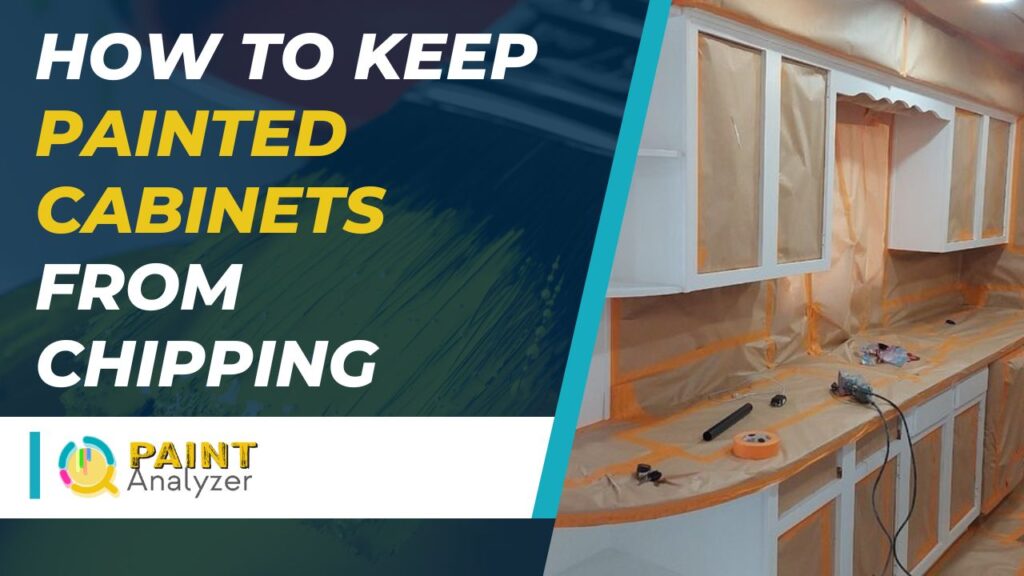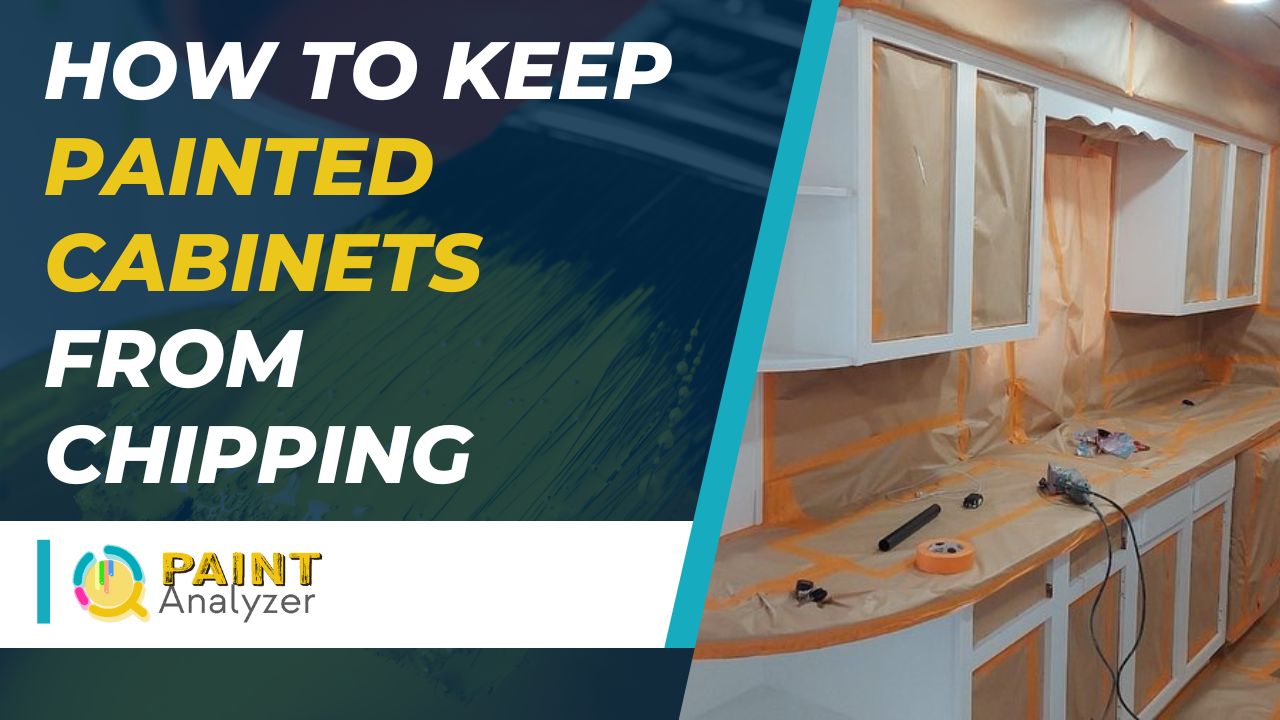Your kitchen cabinets may look stunning after being newly painted, but you’ve already noticed the paint chipping and peeling off after only a few weeks. Understanding the cause of this issue and preventing it from happening again is necessary.
You can do a few things to help prevent this from happening or at least slow it down. Make sure you use high-quality paint that is designed for cabinets. Use a primer before painting to help the paint adhere better. Be sure to use a sealer after painting to protect the paint and make it more durable.
Here, I will give you a step-by-step guide on how to keep your newly painted cabinets from chipping and peeling. So stay tuned and follow these simple tips!

How to Keep Painted Cabinets from Chipping? A step-by-step guide
Like most people, you probably spent much time and effort painting your cabinets. But now you’re noticing that the paint is starting to chip off. Don’t worry. You can do a few things to keep your painted cabinets from chipping.
Step 1: Clean the cabinets
Before painting, you’ll want to ensure the cabinets are clean and free of any dirt or grease. You can do this by wiping them down with a degreaser and a soft cloth.
Step 2: Sand the cabinets
Once the cabinets are clean, you’ll need to sand them down. This will help the paint adhere better and create a smoother finish. You can use fine-grit sandpaper and sand the cabinets by hand or with a power sander.
Step 3: Apply a primer
After the cabinets are sanded, you’ll need to apply a primer. This will help the paint adhere to the cabinets and create a more uniform finish. You can use a brush or a roller to apply the primer.
Step 4: Paint the cabinets
When the primer is dry, you can start painting the cabinets. You’ll want to use a brush or a roller to apply the paint evenly. You can use a paintbrush to get into the corners and crevices.
Step 5: Let the paint dry
After painting the cabinets, you’ll need to let the paint dry. Depending on the paint you’ve used, this can take several hours or overnight. Make sure you read the paint can’s directions carefully to know how long to wait before applying a second coat, if necessary.
Step 6: Apply a top coat
Once the paint is dry, you can apply a top coat. This will help protect the paint and make it more durable. You can use a brush or a roller to apply the top coat.
To get the best results, apply the top coat evenly and in a thin layer. You may need to apply multiple coats to get the desired effect.
Step 7: Let the top coat dry
After you have applied the top coat to your project, you will need to let it dry. This can take several hours or overnight. Allowing the top coat to dry completely ensures your project looks its best.
What to consider when deciding on factory-painted cabinets for your home?
Factory-painted cabinets are a great option for those looking for a high-quality, durable finish. Here are some things to consider when deciding if factory-painted cabinets are the right choice for your home:
The type of paint used
Different types of paint can be used on cabinets, and each has its advantages and disadvantages.
For example, oil-based paints are very durable but difficult to work with. Water-based paints are easier to use but may not be as durable. Talk to your cabinet painter or manufacturer about the best paint type for your project.
The preparation process
Properly preparing the surface of your cabinets is crucial for ensuring a long-lasting finish. This includes sanding down the surfaces to create a smooth base for the paint to adhere to. If you skip this step, you risk peeling or chipping paint in the future.
The painting process
It’s time to start painting once the surfaces have been adequately prepared! Use even strokes and pay close attention to detail while painting. It’s also essential to allow adequate drying time between coats of paint so that everything sets appropriately.
Is a Clear Protective Top Coat Suitable for Painting Cabinets?
A clear top coat is a great way to protect your painted cabinets and keep them looking their best. Here are some tips on choosing and applying a clear top coat: When choosing a clear top coat, make sure it is compatible with the paint you use on your cabinets.
Some top coats can turn yellow over time, so it’s important to pick one that will stay true to the color of your cabinets. Application is key when it comes to a smooth finish. Use a foam roller or brush designed for lacquer for the best results.
Apply thin, even coats, and let each coat dry completely before applying the next. Lacquer-based top coats provide the most durable protection against scratches, stains, and water damage. However, they can be difficult to work with and require special ventilation during application.
If you’re uncomfortable working with lacquer, consider using a water-based polyurethane top coat instead.
Can the Technique for Giving an Antique Look to Cabinets Help Prevent Chipping and Peeling?
Applying antique bathroom cabinet glazing can help prevent chipping and peeling. This technique not only gives cabinets a charming, vintage look but also adds a protective layer that helps to extend the life of the cabinets by making them more resistant to damage and wear.
How Do you Maintain your Painted Cabinets?
Maintaining a clean and organized home is crucial. Here are some essential tips to keep them in top-notch condition:
Dust regularly
Dust can build up on cabinet surfaces, dulling the paint over time. Use a soft cloth or feather duster to dust them weekly. If you notice excessive build-up, you may need to clean the cabinets with a mild soap and water solution. Be sure to dry them thoroughly afterward to prevent water spots from forming.
Wipe up spills immediately
If you spill something on your paint surface, it is important to wipe it up immediately. Allowing spills to sit can cause them to set into the paint and cause damage. In some cases, you may be able to remove the paint entirely. To avoid this, always wipe up any spills as soon as they happen.
Use door and drawer liners
One way to help keep your cabinets looking their best is to use door and drawer liners. These liners help protect the finish of your cabinets from scratches and wear and tear. Choose a liner that’s easy to clean so you can keep it looking its best.
Polish periodically
A good furniture polish can help maintain the shine of your cabinets and make them easier to clean. Apply it sparingly, using a soft cloth, and buff it off well afterward. Use a quality furniture polish and follow the manufacturer’s instructions for best results.
The easy method to keep painted kitchen cabinets from chipping
Conclusion
It’s always frustrating when your newly painted cabinets start to chip and peel. But don’t worry. There are some easy ways to prevent this from happening! Just follow the instructions above, and your cabinets will stay looking freshly painted for years to come.
It would be best to remember to choose the suitable primer, paint, and top coat for your cabinets. Follow the instructions on the tin. Always use a drop cloth or painter’s tape to protect your floors and countertops from paint drips for safety. Thank you for reading!
